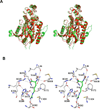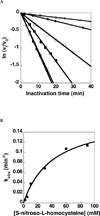Mechanisms of catalysis and inhibition operative in the arginine deiminase from the human pathogen Giardia lamblia
- PMID: 19640561
- PMCID: PMC4590290
- DOI: 10.1016/j.bioorg.2009.06.001
Mechanisms of catalysis and inhibition operative in the arginine deiminase from the human pathogen Giardia lamblia
Abstract
Giardia lamblia arginine deiminase (GlAD), the topic of this paper, belongs to the hydrolase branch of the guanidine-modifying enzyme superfamily, whose members employ Cys-mediated nucleophilic catalysis to promote deimination of l-arginine and its naturally occurring derivatives. G. lamblia is the causative agent in the human disease giardiasis. The results of RNAi/antisense RNA gene-silencing studies reported herein indicate that GlAD is essential for G. lamblia trophozoite survival and thus, a potential target for the development of therapeutic agents for the treatment of giardiasis. The homodimeric recombinant protein was prepared in Escherichia coli for in-depth biochemical characterization. The 2-domain GlAD monomer consists of a N-terminal domain that shares an active site structure (depicted by an insilico model) and kinetic properties (determined by steady-state and transient state kinetic analysis) with its bacterial AD counterparts, and a C-terminal domain of unknown fold and function. GlAD was found to be active over a wide pH range and to accept l-arginine, l-arginine ethyl ester, N(alpha)-benzoyl-l-arginine, and N(omega)-amino-l-arginine as substrates but not agmatine, l-homoarginine, N(alpha)-benzoyl-l-arginine ethyl ester or a variety of arginine-containing peptides. The intermediacy of a Cys424-alkylthiouronium ion covalent enzyme adduct was demonstrated and the rate constants for formation (k(1)=80s(-1)) and hydrolysis (k(2)=35s(-1)) of the intermediate were determined. The comparatively lower value of the steady-state rate constant (k(cat)=2.6s(-1)), suggests that a step following citrulline formation is rate-limiting. Inhibition of GlAD using Cys directed agents was briefly explored. S-Nitroso-l-homocysteine was shown to be an active site directed, irreversible inhibitor whereas N(omega)-cyano-l-arginine did not inhibit GlAD but instead proved to be an active site directed, irreversible inhibitor of the Bacillus cereus AD.
Figures











Similar articles
-
Inactivation of microbial arginine deiminases by L-canavanine.J Am Chem Soc. 2008 Feb 13;130(6):1918-31. doi: 10.1021/ja0760877. Epub 2008 Jan 19. J Am Chem Soc. 2008. PMID: 18205354
-
The electrostatic driving force for nucleophilic catalysis in L-arginine deiminase: a combined experimental and theoretical study.Biochemistry. 2008 Apr 22;47(16):4721-32. doi: 10.1021/bi7023496. Epub 2008 Mar 27. Biochemistry. 2008. PMID: 18366187
-
Kinetic analysis of Pseudomonas aeruginosa arginine deiminase mutants and alternate substrates provides insight into structural determinants of function.Biochemistry. 2006 Jan 31;45(4):1162-72. doi: 10.1021/bi051591e. Biochemistry. 2006. PMID: 16430212
-
Arginine deiminase uses an active-site cysteine in nucleophilic catalysis of L-arginine hydrolysis.J Am Chem Soc. 2004 May 5;126(17):5374-5. doi: 10.1021/ja049543p. J Am Chem Soc. 2004. PMID: 15113205
-
Arginine deiminase has multiple regulatory roles in the biology of Giardia lamblia.J Cell Sci. 2008 Sep 1;121(Pt 17):2930-8. doi: 10.1242/jcs.026963. Epub 2008 Aug 12. J Cell Sci. 2008. PMID: 18697833 Free PMC article.
Cited by
-
Giardia duodenalis arginine deiminase modulates the phenotype and cytokine secretion of human dendritic cells by depletion of arginine and formation of ammonia.Infect Immun. 2013 Jul;81(7):2309-17. doi: 10.1128/IAI.00004-13. Epub 2013 Apr 15. Infect Immun. 2013. PMID: 23589577 Free PMC article.
-
Plasmid vectors for proteomic analyses in Giardia: purification of virulence factors and analysis of the proteasome.Eukaryot Cell. 2012 Jul;11(7):864-73. doi: 10.1128/EC.00092-12. Epub 2012 May 18. Eukaryot Cell. 2012. PMID: 22611020 Free PMC article.
-
X-ray structure and characterization of carbamate kinase from the human parasite Giardia lamblia.Acta Crystallogr Sect F Struct Biol Cryst Commun. 2010 Apr 1;66(Pt 4):386-90. doi: 10.1107/S1744309110004665. Epub 2010 Mar 26. Acta Crystallogr Sect F Struct Biol Cryst Commun. 2010. PMID: 20383005 Free PMC article.
-
Mechanistic studies of agmatine deiminase from multiple bacterial species.Biochemistry. 2010 Nov 2;49(43):9413-23. doi: 10.1021/bi101405y. Biochemistry. 2010. PMID: 20939536 Free PMC article.
-
Treatment of giardiasis: current status and future directions.Curr Infect Dis Rep. 2014 Feb;16(2):396. doi: 10.1007/s11908-014-0396-y. Curr Infect Dis Rep. 2014. PMID: 24493628
References
Publication types
MeSH terms
Substances
Grants and funding
LinkOut - more resources
Full Text Sources
Miscellaneous

